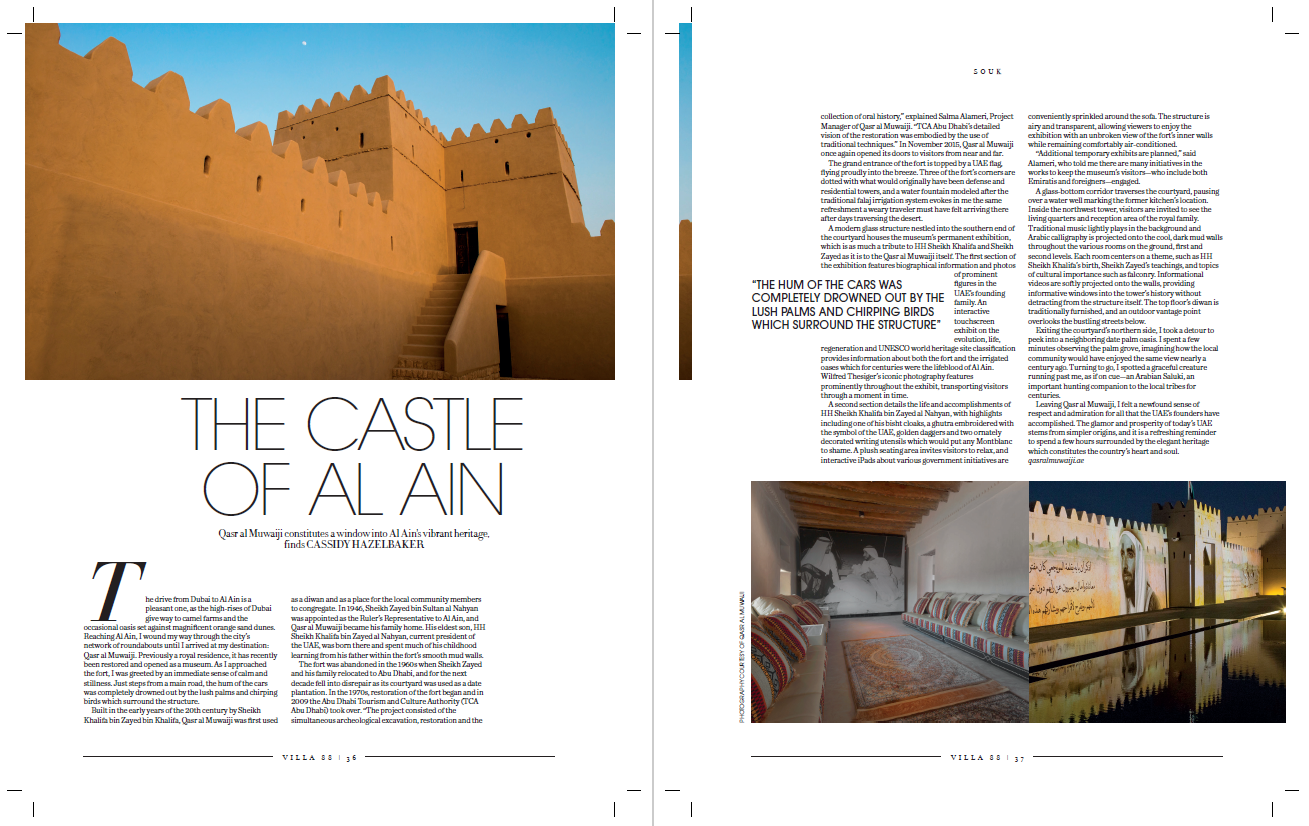The Castle of Al Ain

Qasr al Muwaiji constitutes a window into Al Ain’s vibrant heritage, finds Cassidy Hazelbaker
The drive from Dubai to Al Ain is a pleasant one, as the high-rises of Dubai give way to camel farms and the occasional oasis set against magnificent orange sand dunes. Reaching Al Ain, I wound my way through the city’s network of roundabouts until I arrived at my destination: Qasr al Muwaiji. Previously a royal residence, it has recently been restored and opened as a museum. As I approached the fort, I was greeted by an immediate sense of calm and stillness. Just steps from a main road, the hum of the cars was completely drowned out by the lush palms and chirping birds which surround the structure.
Built in the early years of the 20th century by Sheikh Khalifa bin Zayed bin Khalifa, Qasr al Muwaiji was first used as a diwan and as a place for the local community members to congregate. In 1946, Sheikh Zayed bin Sultan al Nahyan was appointed as the Ruler’s Representative to Al Ain, and Qasr al Muwaiji became his family home. His eldest son, HH Sheikh Khalifa bin Zayed al Nahyan, current president of the UAE, was born there and spent much of his childhood learning from his father within the fort’s smooth mud walls.
The fort was abandoned in the 1960s when Sheikh Zayed and his family relocated to Abu Dhabi, and for the next decade fell into disrepair as its courtyard was used as a date plantation. In the 1970s, restoration of the fort began and in 2009 the Abu Dhabi Tourism and Culture Authority (TCA Abu Dhabi) took over. “The project consisted of the simultaneous archeological excavation, restoration and the collection of oral history,” explained Salma Alameri, Project Manager of Qasr al Muwaiji. “TCA Abu Dhabi’s detailed vision of the restoration was embodied by the use of traditional techniques.” In November 2015, Qasr al Muwaiji once again opened its doors to visitors from near and far.
The grand entrance of the fort is topped by a UAE flag, flying proudly into the breeze. Three of the fort’s corners are dotted with what would originally have been defense and residential towers, and a water fountain modeled after the traditional falaj irrigation system evokes in me the same refreshment a weary traveler must have felt arriving there after days traversing the desert.
A modern glass structure nestled into the southern end of the courtyard houses the museum’s permanent exhibition, which is as much a tribute to HH Sheikh Khalifa and Sheikh Zayed as it is to the Qasr al Muwaiji itself. The first section of the exhibition features biographical information and photos of prominent figures in the UAE’s founding family. An interactive touchscreen exhibit on the evolution, life, regeneration and UNESCO world heritage site classification provides information about both the fort and the irrigated oases which for centuries were the lifeblood of Al Ain. Wilfred Thesiger’s iconic photography features prominently throughout the exhibit, transporting visitors through a moment in time.
A second section details the life and accomplishments of HH Sheikh Khalifa bin Zayed al Nahyan, with highlights including one of his bisht cloaks, a ghutra embroidered with the symbol of the UAE, golden daggers and two ornately decorated writing utensils which would put any Montblanc to shame. A plush seating area invites visitors to relax, and interactive iPads about various government initiatives are conveniently sprinkled around the sofa. The structure is airy and transparent, allowing viewers to enjoy the exhibition with an unbroken view of the fort’s inner walls while remaining comfortably air-conditioned.
“Additional temporary exhibits are planned,” said Alameri, who told me there are many initiatives in the works to keep the museum’s visitors—who include both Emiratis and foreigners—engaged.
A glass-bottom corridor traverses the courtyard, pausing over a water well marking the former kitchen’s location. Inside the northwest tower, visitors are invited to see the living quarters and reception area of the royal family. Traditional music lightly plays in the background and Arabic calligraphy is projected onto the cool, dark mud walls throughout the various rooms on the ground, first and second levels. Each room centers on a theme, such as HH Sheikh Khalifa’s birth, Sheikh Zayed’s teachings, and topics of cultural importance such as falconry. Informational videos are softly projected onto the walls, providing informative windows into the tower’s history without detracting from the structure itself. The top floor’s diwan is traditionally furnished, and an outdoor vantage point overlooks the bustling streets below.
Exiting the courtyard’s northern side, I took a detour to peek into a neighboring date palm oasis. I spent a few minutes observing the palm grove, imagining how the local community would have enjoyed the same view nearly a century ago. Turning to go, I spotted a graceful creature running past me, as if on cue—an Arabian Saluki, an important hunting companion to the local tribes for centuries.
Leaving Qasr al Muwaiji, I felt a newfound sense of respect and admiration for all that the UAE’s founders have accomplished. The glamor and prosperity of today’s UAE stems from simpler origins, and it is a refreshing reminder to spend a few hours surrounded by the elegant heritage which constitutes the country’s heart and soul.